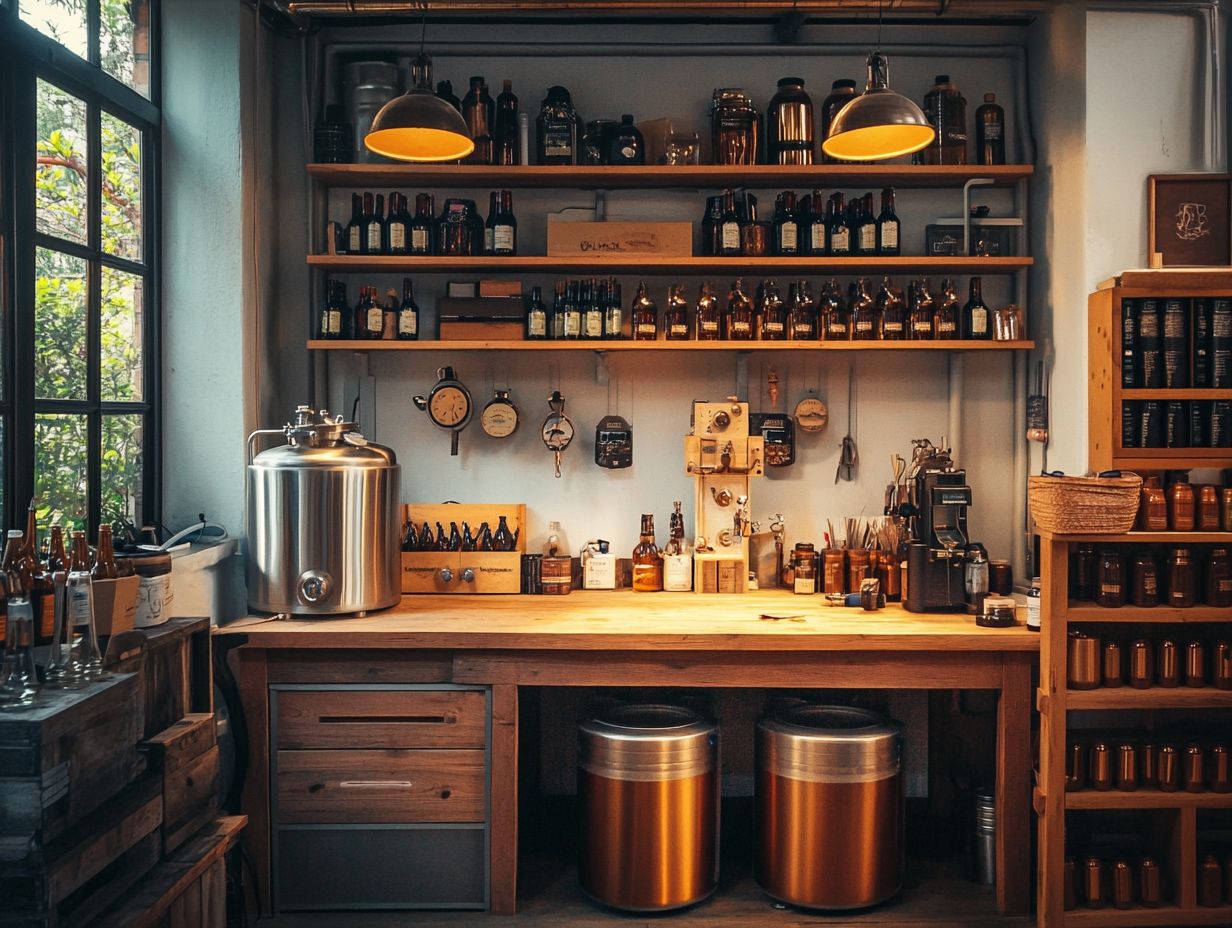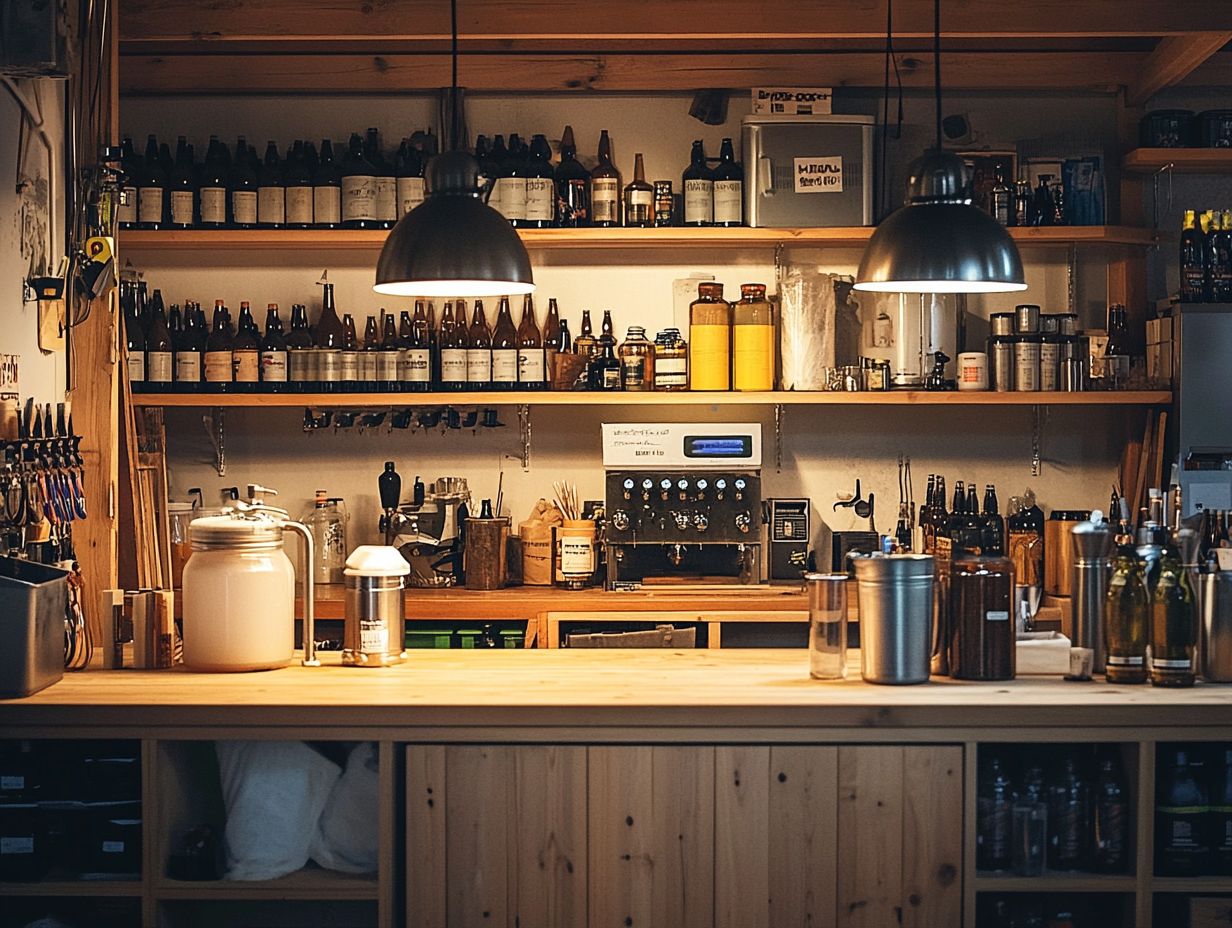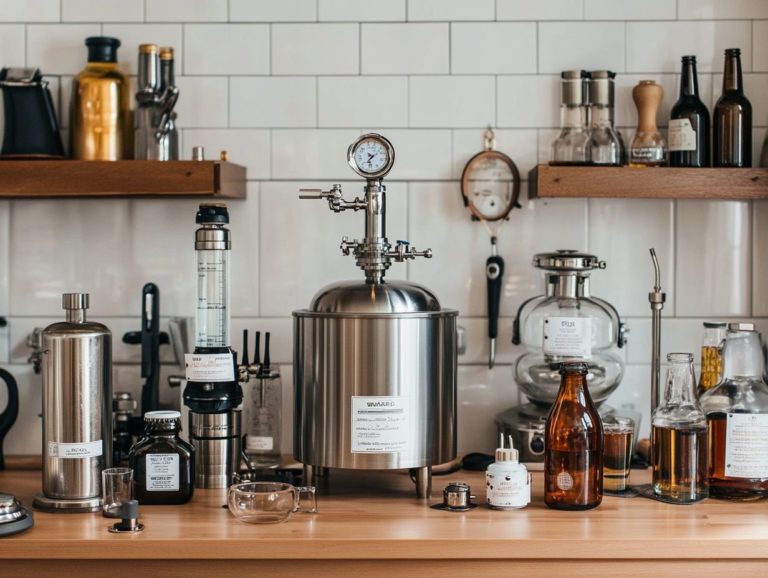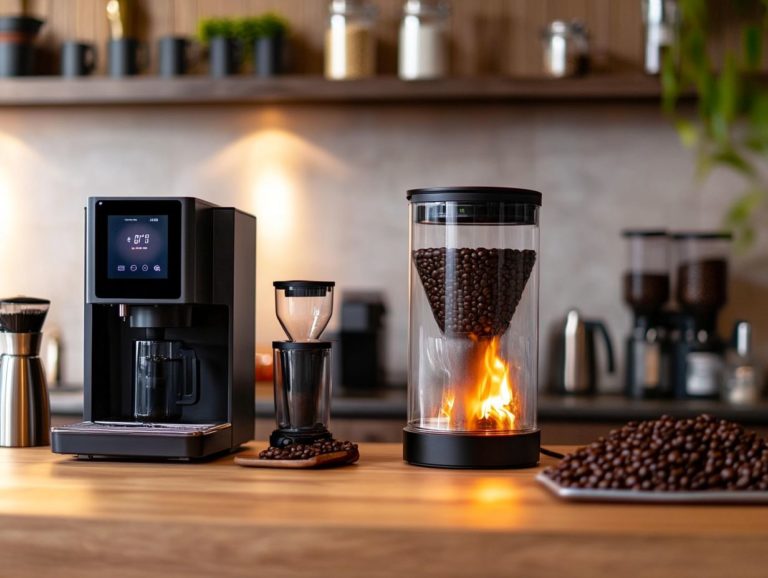How to Set Up a Home Brewery Workshop
Contents
- Homebrewing Your Own Beer
- Key Takeaways:
- Why Set Up a Home Brewery Workshop?
- What Do You Need to Set Up a Home Brewery Workshop?
- 1. Brewing Equipment
- 2. Ingredients
- How to Choose the Right Space for Your Home Brewery Workshop?
- 2. Think About Temperature and Humidity Control
- 3. Evaluate the Ventilation and Lighting
- 4. Consider Noise Levels
- Setting Up Your Home Brewery Workshop
- Tips for Maintaining Your Home Brewery Workshop
- Frequently Asked Questions
- How much space do I need for a home brewery workshop?
- Can I save money by setting up a home brewery workshop?
Homebrewing Your Own Beer
Homebrewing your own beer at home is more than just a hobby; it is a gratifying journey that empowers you to channel your creativity and tailor flavors to your personal taste.
Picture yourself crafting distinctive brews that reflect your unique palate, delighting in the opportunity to share these creations with friends and family.
Explore the invaluable benefits of establishing a home brewery workshop, along with the essential brewing equipment and ingredients you ll need. You’ll also uncover practical tips for selecting the perfect space and ensuring your setup remains in top shape.
Regardless of whether you’re just starting out or you’re a seasoned brewer, this guide is your ultimate key to transforming your brewing aspirations into a delicious reality.
Key Takeaways:

- Homebrewing can save you money and give you full control over the brewing process.
- To set up a home brewery workshop, you will need homebrewing equipment, ingredients, and sanitizing supplies.
- When choosing a space for your workshop, consider the size of your equipment, temperature and humidity control, ventilation and lighting, and noise levels.
Why Set Up a Home Brewery Workshop?
Setting up your own home brewery workshop is an exhilarating venture that allows you to craft unique beers right from the comfort of your garage or a dedicated space. This activity not only sparks your creativity in homebrewing but also offers a fulfilling way to delve into the art and science of beer-making.
From grasping the essentials of brewing equipment to perfecting recipes with high-quality ingredients, creating your personal brewery unveils a world of possibilities for you as a homebrewer. Furthermore, it nurtures a deeper appreciation for the homebrewing process and the craftsmanship involved in each batch, ultimately enriching your experience.
What Are the Benefits of Brewing Your Own Beer?
Homebrewing your own beer comes with a wealth of benefits that go far beyond simply enjoying a refreshing drink. It grants you complete control over the ingredients and brewing process, allowing you to craft personalized flavors and styles that perfectly suit your palate.
This level of customization enables you to experiment with various hops, grains, and additional ingredients, resulting in unique batches that no store can replicate.
The satisfaction of successfully crafting a brew is unmatched, especially when you share your creations with friends and family at gatherings or parties.
Homebrewing can also serve as a cost-effective alternative to splurging on commercial beers, particularly if you plan to brew regularly. By sourcing your ingredients, such as malt extract and specialized hops, you can significantly cut down on expenses over time compared to purchasing craft beers from the store.
Moreover, acquiring new skills is a rewarding aspect of this hobby. Understanding fermentation, carbonation, and various homebrewing techniques not only enhances your brewing experience but also provides a profound sense of accomplishment.
For those just starting out, countless resources are available online, including YouTube tutorials from channels like Short Circuited Brewing and FaceTime, which offer step-by-step guidance, making the process both accessible and enjoyable.
What Do You Need to Set Up a Home Brewery Workshop?
Establishing a home brewery workshop demands a careful and deliberate approach to ensure you have all the right homebrewing equipment, ingredients, and storage solutions for a successful brewing experience.
From choosing the optimal brewing gear, like kettles and fermenters, to sourcing high-quality ingredients such as hops, malt, and yeast, every component is vital to the final product.
Having dedicated storage for your tools and supplies enhances the brewing process and elevates your enjoyment. Don’t overlook the significance of cleanliness and sanitation in your setup; it s crucial to prevent any contamination of your precious batches.
1. Brewing Equipment
To kick off your home brewery workshop, the first thing you need is to acquire the right brewing equipment. This equipment should align with your preferred methods and batch sizes. Essentials include kettles, fermenters, and sanitation tools.
Investing in top-notch brewing equipment is your ticket to brewing success! It is crucial for maintaining temperature control and creating optimal conditions during fermentation. Brands such as Ss BrewTech, Blichmann Engineering, and Anvil provide reliable options for both novices and seasoned brewers, enabling you to craft a setup that perfectly suits your space and brewing style.
As you consider your workshop layout, think about how to facilitate an efficient workflow throughout the brewing process. Opting for equipment with features like adjustable temperature settings, durable materials, and easy-to-clean designs can significantly enhance your brewing experience.
A quality stainless steel kettle, for instance, not only promises longevity but also ensures superior heat distribution key for consistent brewing results. Your brewing area should be designed with ample counter space and proper ventilation to accommodate all your equipment while prioritizing safety and efficiency.
Keep your fermentation vessels in a place where you can keep the temperature stable to prevent unwanted flavors and streamline monitoring. Good shelving solutions will keep everything organized, ensuring you have easy access to all your ingredients and tools.
2. Ingredients
Ingredients form the very foundation of any brewing endeavor, and when it comes to homebrewing, choosing high-quality ingredients is paramount to achieving the flavor profiles you envision in your beer. The quality of water plays a crucial role in the brewing process; thus, investing in a suitable water filtration system, such as a reverse osmosis (RO) system, which removes impurities to improve the taste of your brewing water, can significantly enhance the purity of your brewing water.
You should explore a variety of malts, hops, and yeast types, sourced from reputable suppliers like BeverageFactory.com, NorthernBrewer.com, and BYO magazine, to craft the perfect batch tailored to your individual tastes.
When selecting malts, pay close attention to the colors and flavors they contribute, as these elements will define the character of your final product. For example, incorporating roasted malts can introduce delightful chocolate or coffee notes, while lighter malts offer a refreshing, crisp finish.
Hops are equally important, influencing both aroma and bitterness; experimenting with different hop varieties can elevate your brew, infusing it with floral, citrus, or pine notes that make it truly special. Consider consulting experts like Kal from Short Circuited Brewing for advanced tips.
Don’t overlook yeast, as various strains can yield a diverse array of flavors, from fruity esters to spicy phenols, adding depth to your brew. To preserve the freshness of your ingredients, store them in cool, dark places; exposure to light and heat can compromise their quality.
Understanding water chemistry is essential for any serious homebrewer. Don t miss out grab a water testing kit today to perfect your brewing process, ensuring that every sip showcases the flavors and aromas you intended to create.
3. Sanitizing Supplies
Sanitizing supplies are essential in homebrewing. Maintaining cleanliness is crucial to ensure that your equipment and ingredients don t introduce unwanted bacteria or wild yeast into your beer, which could ruin all your hard work. Using effective sanitizers is imperative for every surface that comes into contact with the beer, including fermenters, bottles, and utensils. By organizing a dedicated sanitizing station, you can streamline your brewing process and make it easier to maintain a pristine environment for each batch you craft. Don’t miss out on checking BYO magazine for advice on the best products to use.
To achieve optimal sanitation, you’ll find various types of sanitizers available, such as iodine-based solutions, peracetic acid, and no-rinse products. Each has its own strengths and weaknesses. It’s vital to understand how each type works and choose the one that fits your specific brewing needs.
Setting up a dedicated sanitizing station can significantly enhance your efficiency. Consider including:
- a large basin for soaking equipment, possibly from Drainersaur,
- spray bottles filled with sanitizer,
- and clearly labeled containers for instant access to supplies.
This way, you can quickly sanitize after use and seamlessly prepare for the next step in your brewing adventure. You might also want to check out sanitizing stations recommended by Fast Kitchen Hoods.
How to Choose the Right Space for Your Home Brewery Workshop?

Choosing the ideal space for your home brewery workshop is an important choice that can significantly enhance your brewing experience, particularly if you re considering setting up in your garage or a dedicated room.
It’s important to assess the available space for your homebrewing equipment, ensuring you have ample room for brewing, fermentation, and storage areas. Don’t overlook the convenience of plumbing for sinks, water systems, and drainage; this will streamline your cleaning and sanitizing routines.
Proper ventilation is equally vital, as it helps manage the heat and odors produced during brewing, allowing you to maintain a comfortable and enjoyable environment. Companies like Fast Kitchen Hoods specialize in creating efficient ventilation solutions for home brewing setups.
1. Consider the Size of Your Equipment
Before starting your homebrewing setup, it’s essential to consider the size of your equipment and how to arrange it efficiently in your chosen space. Consulting with experts like Matt Giovanisci can provide insights into effective setups.
When setting up your home brewery workshop, you want everything to fit comfortably in the chosen space while allowing for an easy workflow and access during the brewing process. Larger equipment demands more room for maneuvering and handling, particularly when lifting heavy kettles or fermenters. Taking accurate measurements of your space and planning your setup thoughtfully will help you avoid potential bottlenecks, making your brewing experience more efficient and enjoyable. Consider following experts like Matt Giovanisci from New Jersey who share their setup tips online.
To effectively assess brewing equipment dimensions, consider common sizes like 5-gallon, 10-gallon, and even larger setups. Keep in mind that configurations may vary based on the type of brewing you plan to do. Sketching a layout of your area can be incredibly beneficial; it allows you to visualize where each piece of equipment will go, ensuring you leave enough space not just for the equipment itself but also for convenient movement between stations. Popular brands like Ss BrewTech, Blichmann Engineering, and Anvil offer a variety of sizes to meet your needs.
Think about placing frequently used tools and ingredients within arm s reach. This little trick can streamline your process and optimize your layout for maximum efficiency. Utilize online resources like BYO magazine and NorthernBrewer.com for more tips on optimizing your workspace.
2. Think About Temperature and Humidity Control
Temperature and humidity control are pivotal in your homebrewing journey. They significantly influence fermentation and the ultimate quality of your brew. Maintaining the ideal temperature during fermentation is crucial to avoiding off-flavors and ensuring the vitality of your yeast. Humidity levels also play a vital role in the drying and storage of your ingredients.
Invest in a reliable temperature control system, like a fermentation chamber, to effectively address these concerns. This will help you achieve consistent results across your batches. Systems like the RO system from BeverageFactory.com can also assist you in maintaining the right water quality.
Utilizing equipment such as humidifiers or dehumidifiers will help you create the optimal brewing environment. A dedicated thermometer and hygrometer a device that measures humidity will enable you to actively monitor conditions, allowing you to make necessary adjustments in real time.
Different beer styles have specific requirements. Lagers thrive in cooler temperatures, while ales prefer warmth. Regularly check these parameters to enhance your fermentation process and elevate the flavor profile of your beer. This ensures a more enjoyable final product. Watch Short Circuited Brewing on YouTube for valuable insights.
3. Evaluate the Ventilation and Lighting
Proper ventilation and lighting are paramount in your home brewery workshop to cultivate a safe and enjoyable brewing environment. Ventilation allows heat and odors to dissipate, while ample lighting ensures effective oversight and management of the brewing process. Neglecting these elements can lead to moisture buildup and unwelcome odors. Inadequate lighting may result in mishaps during both brewing and cleaning. Install exhaust fans and bright, energy-efficient lighting to dramatically enhance your brewing space. Consider companies like Fast Kitchen Hoods for installation.
To evaluate your current conditions, start by observing the airflow and light distribution in the area. If the space feels stuffy or carries a musty scent, upgrade your ventilation system. Using range hoods or inline fans can significantly improve air circulation. For lighting, swap out standard bulbs for LED fixtures to brighten the space and reduce energy consumption. Kal from The Electric Brewery offers excellent advice on setting up efficient ventilation and lighting.
Ensuring proper airflow and illumination minimizes safety risks and optimizes overall brewing efficiency. Regular maintenance and assessment of these elements are vital in creating the ideal brewing atmosphere.
4. Consider Noise Levels
When selecting a space for your home brewery workshop, consider noise levels, especially if you reside in a residential area. Certain brewing equipment, such as electric pumps and chillers, can generate enough noise to disrupt your household or annoy your neighbors.
To keep the peace, use sound-insulating materials or situate your brewing setup in a designated area away from your living spaces. This will help manage any potential noise issues. Consulting with experts like Drainersaur can provide additional solutions.
Beyond physical barriers, be strategic with your equipment choices to minimize sound disturbances. Invest in quieter pumps, insulated kettles, or opt for manual equipment to greatly limit noise production. Additionally, soundproofing your brewing area with acoustic panels can create an effective buffer against unwanted sounds. Adding soft furnishings, like rugs or curtains, can absorb sound and create a more tranquil atmosphere. Using resources like Asana to plan and manage your setup can also be beneficial.
Schedule your brewing sessions during the daytime hours, when noise is less likely to be a concern. This fosters harmony both in your home and in the neighborhood. Consider using FaceTime to communicate with other brewers for real-time advice, especially if you’re setting up a new system.
Setting Up Your Home Brewery Workshop
Setting up your home brewery workshop requires thoughtful organization and planning to cultivate a functional and efficient brewing environment. This allows you to concentrate on crafting exceptional beer.
Start by arranging your equipment and supplies logically. Ensure that everything from brewing kettles to fermentation vessels is easily accessible. Designate a dedicated brewing area stocked with all the essential tools and ingredients. Additionally, have a separate fermentation space to precisely manage the fermentation process.
Finally, establish an organized storage area for your finished beer, ingredients, and equipment. This setup will streamline your future brewing sessions. With this organization, you ll be well on your way to brewing mastery.
1. Organize Your Equipment and Supplies
Organizing your equipment and supplies is a pivotal step in establishing your home brewery workshop. This influences both the efficiency of your brewing process and the final quality of your beer.
Begin by categorizing your equipment into clear groups. Think brewing tools, fermenting vessels, and cleaning supplies, so everything is stored together for quick and easy access. Check out organizational ideas from Fast Kitchen Hoods featured in 2020.
Labeling storage containers and shelves can help maintain an orderly environment. This saves you time and effort during your brewing sessions while preventing cross-contamination.
Consider implementing storage solutions like shelving units that accommodate various sizes of equipment. This allows you to locate what you need at a glance. Stackable bins can be your best friends for smaller items like hops, yeast, and other ingredients, optimizing space and keeping everything neatly organized.
Toolboxes are also fantastic for managing your brewing tools. They protect them from wear and tear while keeping them out of harm’s way.
A clean, well-organized brewing space minimizes distractions. This enables you to focus more intently on the brewing process, ultimately enhancing your overall homebrewing experience.
2. Create a Sanitizing Station

A dedicated sanitizing station is an essential part of your home brewery workshop. It enhances cleanliness and minimizes the risk of contamination throughout the brewing process.
Equip this station with all the necessary sanitizing supplies, including cleaning agents, brushes, and disinfectants. Ensure everything is organized within easy reach of your brewing area. Incorporating a sink or basin for rinsing equipment can streamline the sanitization process, ensuring your brewing vessels and tools are always in top-notch condition for every batch.
You should include items such as:
- Spray bottles filled with ready-to-use sanitizers
- A set of dedicated cloths for drying
- A thermometer to verify the best temperatures for cleaning
Best practices suggest that your station should be arranged in a linear fashion. Organize tools and supplies in the order you ll use them starting from cleaning to rinsing and finally sanitizing. This layout reduces unnecessary movement and streamlines your workflow, making the process feel more intuitive and effective.
By ensuring everything is within arm’s reach and clearly labeled, following this setup makes sanitization a breeze! You can guarantee a consistently high-quality brewing experience every time.
Conclusion
In conclusion, setting up your home brewery workshop is an exciting journey. By organizing your equipment, creating a dedicated sanitizing station, and maintaining a clean environment, you’ll enhance your brewing experience. So, roll up your sleeves and start crafting the perfect space for your brewing adventures!
3. Set Up Your Brewing Area
Setting up your brewing area is a pivotal step in crafting your home brewery workshop. This space is where you will transform raw ingredients into your signature beer. Start by selecting a flat, sturdy surface for your brewing equipment. Ensure there s ample room for kettles, fermenters, and all the necessary tools.
It s vital that your brewing area is conveniently accessible to water and power sources. Equip it with safety features, such as fire extinguishers, for emergencies. If you’re in Colorado, local suppliers can provide additional support for your setup.
To elevate the efficiency of your brewing process, consider the layout in a manner that minimizes unnecessary movements. Position your equipment in a logical sequence that follows the brewing steps, from mashing to boiling and fermentation.
Incorporating shelving or cabinets from places like BeverageFactory.com will provide easy access to ingredients and supplies, reducing the time spent searching for what you need. A well-organized space enhances productivity and fosters a safer environment.
Always prioritize keeping the floor clear and ensuring tools are stored in designated areas to prevent accidents. This will make your brewing experience enjoyable and stress-free.
4. Set Up Your Fermentation Area
The fermentation area is the heart of your home brewery, where the true alchemy of brewing takes place. Here, sugary wort transforms into alcohol, developing distinctive flavors and aromas that will define your beer.
To craft this essential space, choose a cool, dark spot with stable temperature control. This encourages yeast activity and wards off any unwelcome off-flavors. You might want to invest in fermentation vessels from brands like Ss BrewTech or Blichmann Engineering, which feature temperature control to create the ideal conditions for every batch.
Insulating your fermentation area is crucial for maintaining a steady temperature. This protects it from external fluctuations that could derail your efforts. Implementing temperature monitoring systems allows you to access real-time data, enabling prompt adjustments to safeguard yeast performance.
Position your fermenters strategically, keeping them away from direct sunlight and physical disturbances that could disrupt the fermentation process. By focusing on these elements, you can cultivate an environment that enhances fermentation and leads to high-quality beer, rich with the flavors and aromas you’ve intended.
5. Create a Storage Area for Your Finished Beer
Establishing a dedicated storage area for your finished beer is essential in your home brewery workshop. This space provides a safe and organized haven for your bottled or kegged beers until they re ready to be savored. Make sure this storage area is cool, dry, and dark to preserve the quality of your beer and prevent spoilage.
Opt for shelving or other smart storage solutions from NorthernBrewer.com that allow for easy organization and access to your finished products. This way, you can effortlessly track your batches and share them with friends and family.
Consider various storage options, such as shelving units designed specifically for bottles and custom racks for kegs. These can optimize space and enhance accessibility. Keeping ideal conditions is key to enjoying your beer at its best!
When you store your beer properly, every sip bursts with the flavor you crafted! Choosing the right equipment not only contributes to organization but also safeguards the integrity of your craft creations, ensuring that each brew is enjoyed at its best.
Tips for Maintaining Your Home Brewery Workshop
Maintaining your home brewery workshop is essential for achieving consistent quality and successful brewing experiences. Neglecting maintenance can lead to equipment failures or off-flavors in your beer, which is definitely not the outcome you want. Consider reading resources like BYO magazine for additional tips and tricks.
Make it a habit to regularly check and clean your equipment, ensuring that everything from fermenters to brewing kettles is in optimal condition before each brewing session. Additionally, pay attention to how you store your ingredients and keep an eye on their freshness, as this can significantly impact the quality of your brews over time.
By establishing a routine maintenance schedule, possibly using tools like Asana for task tracking, you can extend the life of your equipment and enhance the overall success of your home brewing ventures.
1. Keep Your Equipment Clean and Sanitized
Maintaining immaculate brewing equipment is paramount for preserving the integrity of your beer and warding off contamination from pesky bacteria or wild yeast. Establishing a meticulous cleaning routine after each brewing session is key. This should involve thoroughly washing all equipment with hot water and an appropriate cleaner, such as those recommended by Kal, followed by effective sanitization before your next use.
By prioritizing cleanliness, you ensure that each batch of beer is crafted under optimal conditions, allowing the true flavors of your ingredients to flourish.
To attain the finest results, begin by soaking vessels, fermenters, and utensils in a hot, soapy water solution, ensuring that every trace of previous brews is eradicated. Pay particular attention to those hard-to-reach nooks and crannies where residue might hide, as they can serve as a breeding ground for bacteria. For more tips, you could watch tutorials from channels like Short Circuited Brewing on YouTube.
Once you ve washed everything, reach for a non-toxic sanitizer, such as Star San or iodine-based solutions, and apply it meticulously to all surfaces that will come into contact with the beer. Letting the equipment air dry afterward is advisable since moisture can inadvertently promote bacterial growth.
By diligently inspecting and adhering to this cleaning routine, you will significantly enhance the quality of your final product while extending the lifespan of your brewing equipment.
2. Store Ingredients Properly
Properly storing your brewing ingredients is crucial for maintaining their quality and ensuring that every batch of beer you create is a success. This means giving hops, grains, and yeast the right conditions to prevent spoilage and preserve their flavors. Consider utilizing an RO system for water to ensure the highest quality ingredients.
Pay attention to the specific needs of each ingredient, as doing so will elevate your brewing process. For example, keep hops away from light and excessive heat to protect those essential oils, while grains thrive in lower humidity to fend off mold growth. Yeast, being a living organism, prefers the cool embrace of refrigeration but should gradually warm to room temperature before use to ensure it remains active and ready to work its magic.
The freshness of these ingredients plays a direct role in the final taste of your beer, underscoring the importance of proper storage practices. By mastering these techniques, you can achieve the best flavor profiles and truly elevate your brewing game.
3. Monitor Temperature and Humidity Levels

Monitoring temperature and humidity levels in your home brewery workshop is essential for achieving consistent results and the highest possible flavor profiles in your beer. Even minor fluctuations can create undesirable fermentation conditions and lead to off-flavors that are far from ideal. To keep your brewing and fermentation areas in check, utilize thermometers and hygrometers. Adjust the environment as necessary to maintain optimal conditions. By cultivating a stable brewing environment, you enhance the overall quality of your beer, ensuring that each batch aligns with your expectations.
Invest in advanced equipment like programmable digital controllers. These allow for real-time adjustments. Positioning your thermometers and hygrometers in various locations offers you a comprehensive view of the entire brewing space, helping you identify hot or cold spots that could influence the fermentation process.
Proper ventilation plays a critical role. It helps to regulate humidity levels and prevents excessive moisture that could encourage unwanted bacteria or wild yeast strains.
Regular calibration of your instruments ensures accuracy. This guarantees you create optimal conditions for fermentation and the overall quality of your beer throughout its brewing journey.
4. Regularly Check for Leaks or Damage
Regularly checking for leaks or damage in your brewing equipment is a crucial maintenance task that can save you from pricey repairs and ensure your home brewery runs smoothly. Take the time to inspect connections, hoses, and fittings for any signs of wear and tear. Address leaks promptly to protect the integrity of your brewing process. By staying vigilant and maintaining your equipment, you enhance both the safety and quality of your brewing experience.
This proactive approach guarantees top performance and extends the lifespan of your essential equipment. To streamline this process, consider creating a routine inspection checklist that targets common trouble spots like valves, clamps, and seals.
Consistently examine the condition of your fermentation vessels, heating elements, and cooling systems this is key.
Be sure to conduct these inspections after every brewing session and make timely repairs whenever you notice issues. By doing this, you can significantly minimize the risk of malfunctions and boost the efficiency of your brewing operations, ultimately leading to superior results in your craft.
Frequently Asked Questions
What is a home brewery workshop?
A home brewery workshop is a dedicated space in your home for brewing and crafting your own beer. It typically includes equipment, tools, and storage for ingredients. Some enthusiasts in Colorado and New Jersey have even converted parts of their homes into specialized brewing areas.
How do I choose the right location for my home brewery workshop?
The ideal location for your home brewery workshop is a cool, dry, and well-ventilated area. This could be a spare room, a basement, or even a garage. Avoid areas with direct sunlight or extreme temperature changes. If necessary, install equipment like Fast Kitchen Hoods for better ventilation.
What equipment do I need to set up a home brewery workshop with Anvil or other brands?
The essential equipment for a home brewery workshop includes a brewing kettle, fermenters, bottling equipment, a thermometer, and high-quality brands like Ss BrewTech and Blichmann Engineering. You may also want to invest in a hydrometer, a pH meter, a wort chiller for more advanced brewing techniques, and additional equipment from vendors like BeverageFactory.com and NorthernBrewer.com.
Do I need any special skills or knowledge to set up a home brewery workshop with Drainersaur?
No, you do not need any special skills or knowledge to set up a home brewery workshop. However, it is helpful to have some basic understanding of the brewing process and sanitation practices to ensure the quality and safety of your beer. For learning resources, you can check out BYO magazine, YouTube channels like Short Circuited Brewing, or even join online communities that use platforms like Asana and FaceTime for collaboration.
We encourage you to share your brewing experiences or ask questions as you embark on your brewing journey!
How much space do I need for a home brewery workshop?
The amount of space you need for a home brewery workshop depends on the equipment and setup you choose.
A small setup fits in a corner. A larger setup may need a garage or basement.
For larger setups, use a Reverse Osmosis (RO) system for water purification. Ensure proper ventilation with kitchen hoods.
Can I save money by setting up a home brewery workshop?
Yes, setting up a home brewery workshop can save you money in the long run.
Brewing your own beer is often cheaper than buying craft beer.
You can customize your recipes and ingredients to fit your budget and preferences.
Enthusiasts like Matt Giovanisci from New Jersey share budget-friendly tips. Kal from Colorado also provides great recipes.






